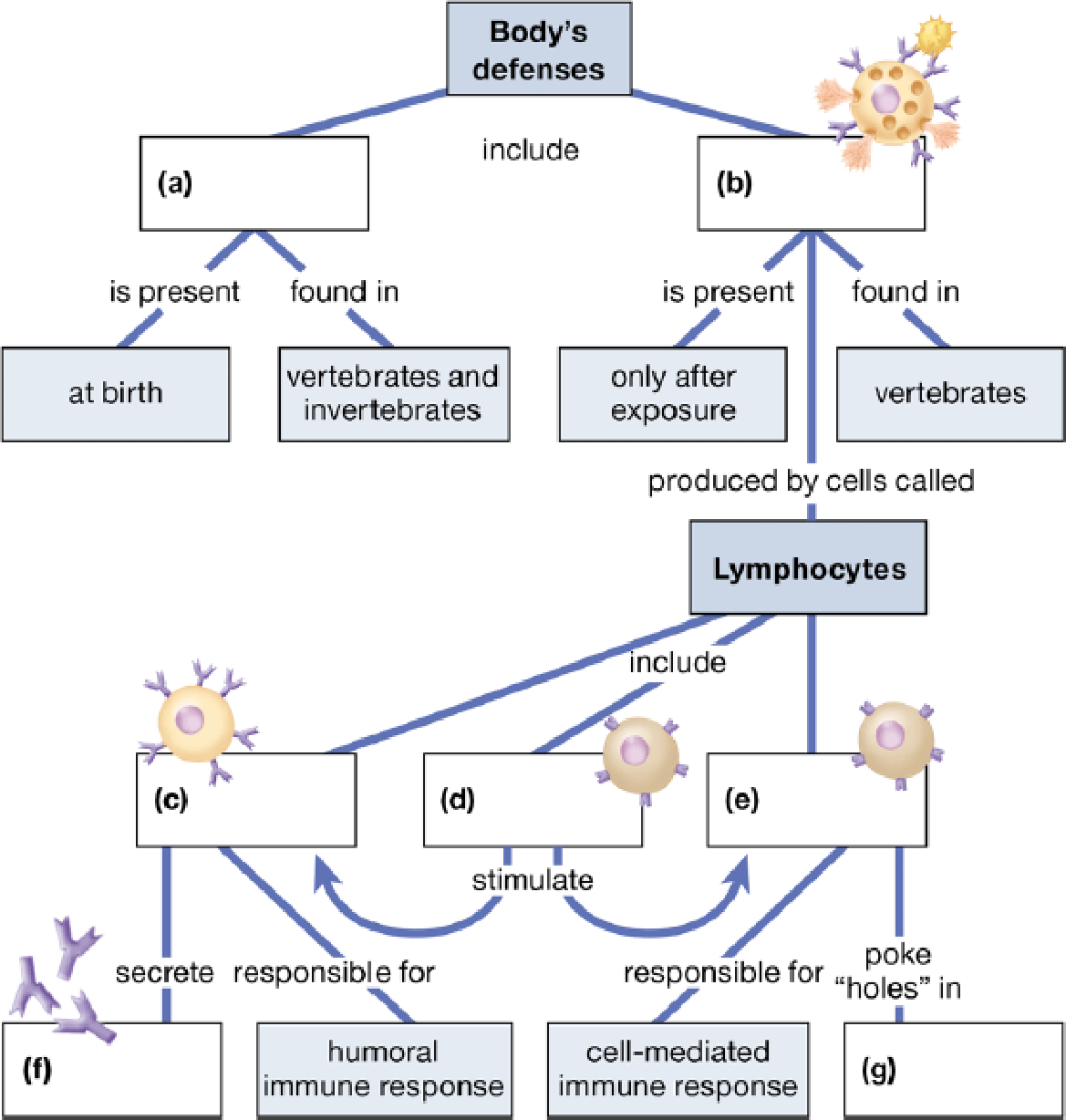
Concept explainers
Complete this concept map to summarize the key concepts concerning the body’s defenses.

To complete: The given concept map and to summarize the key concepts concerning body’s defense.
Introduction:
The immune system of the human body is divided into two main branches, namely the innate immunity and the adaptive immunity. Innate or the body’s first defense mechanism is present since birth and this defense mechanism are non-specific, which means it acts as a barrier in for every foreign body irrespective of its structure. Adaptive immunity of the body comes in later stages, when the body is introduced to pathogens. It is a specific type of defense mechanism.
Answer to Problem 1CC
Pictorial representation: A concept map explaining immune defense mechanisms of body is presented in Fig.1.

Fig. 1: Map depicting the concept of body’s defenses
Explanation of Solution
a)
Correct answer: Innate immunity.
Explanation:
Innate immunity is the immunity present in the body since birththat helps in protecting the body from infection. Hence the correct answer is innate immunity.
(b)
Correct answer: Adaptive immunity.
Explanation:
Adaptive immunity is the immunity that is acquired by the body when the body comes in contact with the foreign agent. Hence the correct answer is adaptive immunity.
(c)
Correct answer: B-cells.
Explanation:
B-cells are the immune cells that help in the protecting the body from infection and is a part of the humoral immunity. Hence the correct answer is B-cells.
(d)
Correct answer: Helper T-cells.
Explanation:
Helper T-cells helps in the recognizing the foreign antigen and instigate the release of antibodies. Hence the correct answer is helper T-cells
(e)
Correct answer: Cytotoxic T cells.
Explanation:
Cytotoxic T-cells help in neutralizing the antigen carrying cell by attaching to it and releasing degenerative enzymes. Hence the correct answer is cytotoxic T cells.
(f)
Correct answer: Antibodies.
Explanation:
Antibodies are protein molecules that help in the recognizing foreign antigen and eliciting an immune response. Hence the correct answer is antibodies.
(g)
Correct answer: Infected body cells.
Explanation:
Infected body cells are the host’s cells that are penetrated by the infectious agent. Hence the correct answer is infected body cells.
Want to see more full solutions like this?
Chapter 24 Solutions
CAMPBEL BIOLOGY:CONCEPTS & CONNECTIONS
- In one paragraph show how atoms and they're structure are related to the structure of dna and proteins. Talk about what atoms are. what they're made of, why chemical bonding is important to DNA?arrow_forwardWhat are the structure and properties of atoms and chemical bonds (especially how they relate to DNA and proteins).arrow_forwardThe Sentinel Cell: Nature’s Answer to Cancer?arrow_forward
- Molecular Biology Question You are working to characterize a novel protein in mice. Analysis shows that high levels of the primary transcript that codes for this protein are found in tissue from the brain, muscle, liver, and pancreas. However, an antibody that recognizes the C-terminal portion of the protein indicates that the protein is present in brain, muscle, and liver, but not in the pancreas. What is the most likely explanation for this result?arrow_forwardMolecular Biology Explain/discuss how “slow stop” and “quick/fast stop” mutants wereused to identify different protein involved in DNA replication in E. coli.arrow_forwardMolecular Biology Question A gene that codes for a protein was removed from a eukaryotic cell and inserted into a prokaryotic cell. Although the gene was successfully transcribed and translated, it produced a different protein than it produced in the eukaryotic cell. What is the most likely explanation?arrow_forward
- Molecular Biology LIST three characteristics of origins of replicationarrow_forwardMolecular Biology Question Please help. Thank you For E coli DNA polymerase III, give the structure and function of the b-clamp sub-complex. Describe how the structure of this sub-complex is important for it’s function.arrow_forwardMolecular Biology LIST three characteristics of DNA Polymerasesarrow_forward
 Human Heredity: Principles and Issues (MindTap Co...BiologyISBN:9781305251052Author:Michael CummingsPublisher:Cengage Learning
Human Heredity: Principles and Issues (MindTap Co...BiologyISBN:9781305251052Author:Michael CummingsPublisher:Cengage Learning Human Physiology: From Cells to Systems (MindTap ...BiologyISBN:9781285866932Author:Lauralee SherwoodPublisher:Cengage Learning
Human Physiology: From Cells to Systems (MindTap ...BiologyISBN:9781285866932Author:Lauralee SherwoodPublisher:Cengage Learning Biology: The Dynamic Science (MindTap Course List)BiologyISBN:9781305389892Author:Peter J. Russell, Paul E. Hertz, Beverly McMillanPublisher:Cengage Learning
Biology: The Dynamic Science (MindTap Course List)BiologyISBN:9781305389892Author:Peter J. Russell, Paul E. Hertz, Beverly McMillanPublisher:Cengage Learning Human Biology (MindTap Course List)BiologyISBN:9781305112100Author:Cecie Starr, Beverly McMillanPublisher:Cengage Learning
Human Biology (MindTap Course List)BiologyISBN:9781305112100Author:Cecie Starr, Beverly McMillanPublisher:Cengage Learning Medical Terminology for Health Professions, Spira...Health & NutritionISBN:9781305634350Author:Ann Ehrlich, Carol L. Schroeder, Laura Ehrlich, Katrina A. SchroederPublisher:Cengage Learning
Medical Terminology for Health Professions, Spira...Health & NutritionISBN:9781305634350Author:Ann Ehrlich, Carol L. Schroeder, Laura Ehrlich, Katrina A. SchroederPublisher:Cengage Learning





